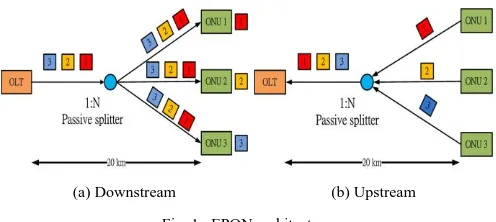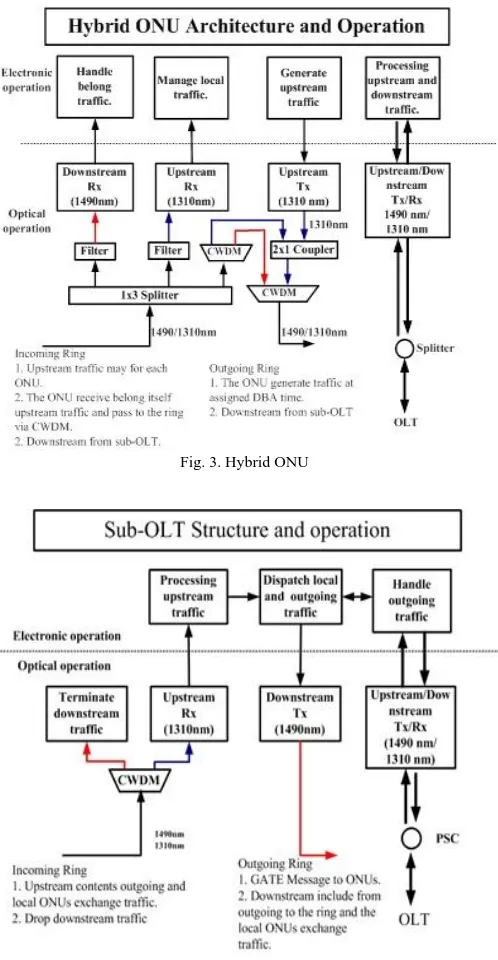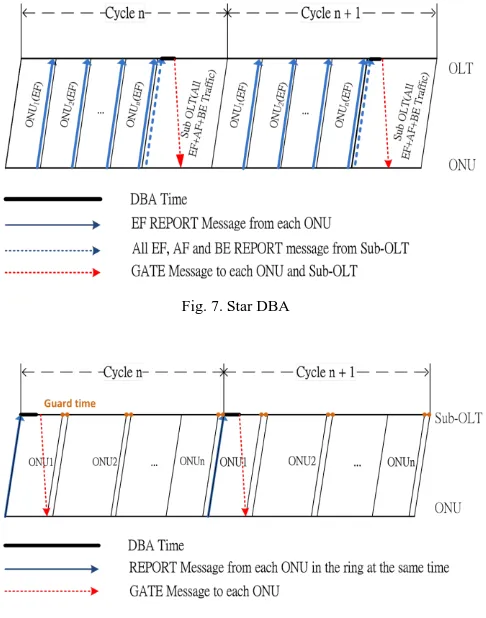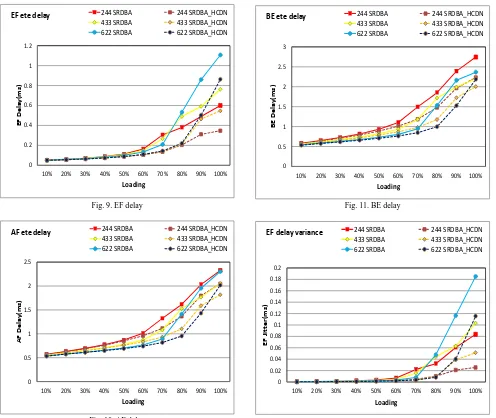Abstract—Video on Demand (VoD) service is regard as one of the most important services in next decade. It requires high speed and huge bandwidth to guarantee the quality of service (QoS). Ethernet passive optical network (EPON) is regarded as one of the best solutions on access network, due to high speed and low cost. The Star-Ring EPON architecture is an evolution of EPON which provide better local transmission and fault tolerance ability. The Content Delivery Network (CDN) architecture, in which the video content is cached at a location closer to the user, is a widely used methodology to reduce the latency of VoD service. Therefore, in this paper, we propose a mechanism which combines the advantage of Star-Ring based EPON and CDN to improve QoS. We design a new Sub-OLT which includes storage to store video files and serve at local. Thus, it can reduce the bandwidth between optical line terminal (OLT) and optical network unit (ONU). Simulation results have shown that our proposed mechanism can improve the system performance and quality of service in terms of packet delay, jitter.
Index Terms—Video on demand (VoD), Star-Ring, EPON, content delivery network (CDN)
I. INTRODUCTION
N addition to the rapid development of the Network hardware technology in recent years, the number of Internet users has been also increased. In this growth leads to different kinds of services, including cloud computing, Voice over IP (VoIP) and Video on Demand (VoD), occupy a lot of network resource. The popularity of high definition television and smart TV makes more high definition video stream need [1]. It is predicted that from 2011 to 2016, the growth rate of standard-definition VoD is 6%, the growth rate of high-definition VoD is 31% and the growth rate of 3D VoD is 109% [2]. Such heavy traffic transmission will cause a burden, and also can lead to more pressure for the network operators.
Nowadays, the local network on the user side supports up to 1Gbps speed rate capacity while the access network can supports to 10Gbps. However, the access network between user side and core network can only hold up to a transmission
Manuscript received December 23, 2013; revised January 24, 2014. This work was supported in part by the National Science Council of Taiwan (NSC 100-2218-E-539-002-MY2 and NSC 102–2221–E-539-004-).
Zen-Der Shyu is with the Department of General Studies, Army Academy, Chung-Li, 32092, Taiwan (e-mail: alex@aaroc.edu.tw).
I-Shyan Hwang is with the Department of Information Communication, Yuan-Ze University, Chung-Li, 32003, Taiwan (e-mail: ishwang@saturn.yzu.edu.tw).
Chun-Wei Feng is with the Department of Computer Science and Engineering, Yuan-Ze University, Chung-Li, 32003, Taiwan (e-mail: s1006035@mail.yzu.edu.tw).
rate capacity of less than 10Mbps or even just a few Kbps in some cases. The “last mile” still remains the bottleneck between local area networks (LANs) and the core network.
One of the solutions to the last mile is Ethernet Passive Optical Network (EPON) technology [3], of which features data deployment through passive components, has gained the most attention in the industry. It is composed of optical line terminal (OLT), passive star coupler (PSC) and optical network units (ONU). EPON has many advantages; such as simplicity, low deployment cost, high bandwidth and low transmission signal loss. In the downstream, the EPON use broadcasting to transfer stream to each ONU, shown as Fig. 1(a). The EPON use Time-division multiplexing (TDM) in upstream, shown as Fig. 1(b).
EPON should avoid collision problem in upstream direction, otherwise data cannot transmit successfully. Carrier Sense Multiple Access with Collision Detection (CSMA/CD) can solve this problem, however, PON’s transmit distance is up to 100 Km, in such long distance CSMA/CD is not efficient. In Time Division Multiple Access (TDMA) [3], that gives every ONU a static time slot to avoid collision. Furthermore, fixed time slot scheme in TDMA will waste bandwidth and decrease bandwidth utilization. For the reason, Dynamic Bandwidth Allocation (DBA) was purposed in [4] to solve this problem. This mechanism dynamically assign appropriate time slot to each ONU for increasing the bandwidth utilization.
VoD transmission method can be divided into Client/Server and Point-to- Point (P2P) mode [5, 6]. Each node works as both user and provider in P2P mode, however, it filled with many uncertainties in this transmit mode. For example, how to search for data efficiently, searching caused network a lot of pressure, the different uploading bandwidth of each node. In addition, P2P cannot ensure the QoS because the limited ability of each node.
In traditional Client/Server mode, all users send their requests to the Server, and then the Sever sends data to the users separately. The propagation delay is longer because
Hybrid Content Delivery Network Mechanism
for Video Streaming on Star-Ring based EPON
Zen-Der Shyu, I-Shyan Hwang and Chun-Wei Feng
I
[image:1.595.303.551.184.295.2](a) Downstream (b) Upstream
transmission distance is long in Client/Server mode. And it is easier to make the server loading too heavy. In order to reduce transmission delay, Content Delivery Network (CDN) was proposed in [7]. This mechanism adds Edge Server near the client side, and restores video data by pull, shown as Fig. 2. When user wants to watch movie, just ask Edge Server for the data. User can find the data nearby to improve the transmit efficiency and decrease the pressure of backbone network.
In this paper, we develop a new scalable Star-Ring architecture to deliver the VoD traffic in EPON. To provide an efficient system, this paper use CDN to serve video file at local area. In the proposed Star-Ring architecture, Sub-OLT consists of a storage unit that can store the video file which had been requested. By this new component, some of the video requests would be solved at local to conserve feeder fiber bandwidth and reduce the loading of video server. The rest of this paper is organized as follows. Section II introduces the details of Star-Ring architecture. Our purposed scheme is described in Section III. Section IV presents the simulation result of the proposed scheme. Finally, Section V gives the conclusions of this paper.
II. RELATED WORK
In our previous work [8], we assigned one ONU at local side to be Sub-OLT, and designed two DBA scheme. In [8], Star Dynamic Bandwidth Allocation (SDBA) in OLT which handles EF traffic of each ONU, and is transmitted by traditional tree architecture. In addition, Ring Dynamic Bandwidth Allocation (RDBA) in Sub-OLT which handles AF and BE traffic of each ONU transmitted by the ring architecture. Two new components, hybrid ONU and Sub-OLT were proposed in [8], shown as Figs. 3-4 to improve local transmission efficiency by these two components. In hybrid ONU, a 1x3 splitter is used to make the signal into three copies. The first copy goes through a filter to filter out the downstream (1490 nm) traffic, and then receive the packets belongs to itself. Hybrid ONU may receive packets that sends from neighbor ONUs by the second copy goes through a filter to filter out the upstream (1310 nm) traffic. The last copy goes through the CWDM to separate downstream and upstream traffic. For the downstream, it will pass to another CWDM directly. For the upstream traffic, it will be combined with the 1310nm traffic which the original ONU is expected to upload through a 2x1 coupler. And then, the traffic goes through CWDM to
transfer the bypassed downstream traffic to the ring. The proposed Sub-OLT is responsible for transmit all the AF and BE traffic to OLT which is sent by ONUs from local ring. When ring traffic comes, it will goes through the CWDM to separate downstream and upstream traffic. Downstream traffic will be terminated, and upstream traffic will goes to buffer to wait until the grant message send form OLT.
III. PROPOSED ARCHITECTURE
[image:2.595.308.557.48.528.2]The video on demand (VoD) growth rapidly, this paper adopts the Hybrid ONU and upgrades the original Sub-OLT architecture in [8] to enhance efficiency of network. Storage is created in Sub-OLT, this make Sub-OLT can work as an Edge Server in CDN network. This proposed architecture also designs a table in Sub-OLT to record file name, where the file stored and how many times it had been read. By this
Fig. 2. Video architecture.
Fig. 3. Hybrid ONU
[image:2.595.64.271.51.189.2]table, it enhanced the search time and reduces bandwidth waste to provide more network service quality and reliability.
A. Delivery Operation
In the proposed architecture, there are two cases when user send request for video file. First, the request file is in Sub-OLT; the other is the request file is in Video Server.
B. Sub-OLT Architecture
Sub-OLT is not only an ONU but also handle ring traffic. It needs extra two pair receiver and transmitter for ring transmission. Here also need extra queue for ring traffic. We add two routing tables to determine the packet is video or not. The most important component for our propose architecture is storage unit. The storage unit is composed of storage, a micro process unit (MPU) and a controller unit. Detail function and operation of the Storage Unit is mention as follow:
1) Storage
We add a conventional hard disk here due to it is cheapest per GB. The storage is finite; hence we need some operation to deal if the space is not enough. The detail operation will introduce later.
2) MPU
The Micro Process Unit is work for the video traffic. MPU can support to do higher layer operation such as extract packet to get the information and store it in the table.
3) Controller unit
We define several functions in controller unit to get information from packets such as name, metadata, etc. The defined functions in the storage device are shown in Table I. The detail is described in the next subchapter.
In the Upstream, when video packets arrive, we run the
Extract function first to extract the information from packets,
such as source MAC address, file name, and metadata etc.
TABLEI FUNCTIONS OF CONTROLLER
Function Argument Task
Extract Packet Return related information of packet
Search Name 1 if the name exist; otherwise 0
Read Metadata Name Read metadata of video file
Read Name, mean
buffer size
Retrieve data (video file)
Add Packet Add header to the data and encapsulate to Ethernet frame
Send User MAC Send data to user
Forward Packet Send video request to Sub-OLT BE queue
Remove Packet Remove header from packet
Save Packet Save or append packet data
Update table Name, host, counter
Increase the number of video request by 1
Free space Disk Return1 if enough space exist for saving the movie
Delete File Delete a data with minimum counter
[image:3.595.313.537.51.772.2]Fig. 5. Flowchart of Upstream
After that, Search function will be executed to search the file name, which extracted from report packets is in the table or not. If the file name does not hit in the table, we use Forward
function to pass this report message to the queue in Sub-OLT, and then work as conventional way. Otherwise, the control unit in Sub-OLT will ReadMetadata, read the information of the video file (include bit rate and frame per second, etc.). The Read function is defined to read the data with buffer size from the file. By Metadata and Read function, we can send suitable packet size to avoid packets be dropped. Before start sending packet, Add function will run to encapsulate the packet into Ethernet frame. Send function is design for sending the request file back to user by MAC address. The three functions above should repeat until end of file (EOF). After all the function completed, Update table will run to increase the counter and save. The detailed operation of upstream is shown in Fig. 5.
In the downstream, when video packets arrive from video server to Sub-OLT, the Extract function will run to get the information. Free space function is to check the storage space. The Delete function will be executed to delete the file with minimum counter when space is not enough. Otherwise, using Remove function to remove header and get a pure file and Save the file in the storage. The above procedure will continue until EOF. After all the operation above done, we add the file name in the table by Update. The detailed operation of downstream is shown in Fig. 6.
C. Dynamic Bandwidth Allocation (DBA)
There are two DBA in our previous work [8], one is Star DBA in OLT and the other one is Ring DBA in Sub-OLT. As mention in second part, we can use Figs. 11-12 to describe
the detail. 1) SDBA
The SDBA is located at the OLT which manages EF traffic from each ONU and other traffics from Sub-OLT by tree structure. EF traffic contains delay sensitive packet such as voice message which has the highest priority in transmission. Here, each ONU will upload EF traffic and report message according to the time slots that given from SDBA. The remaining time will be served for AF and BE traffics in Sub-OLT. In order to reduce the idle time, SDBA starts calculate the grant time of next cycle when Sub-OLT transmission beginning, shown as Fig. 7.
2) RDBA
In the proposed ring-architecture, the upstream data is transmitted in uni-direction via channel (1310nm) at the same fiber. All ONUs send their report messages to Sub-OLT at same time, the signal will pass through ONUs to the Sub-OLT. When signal arrives at the next ONU, the next ONU data already send to next and next ONU. Hence, Sub-OLT will receive all the report messages from ONUs in a short time without collision. After all the report message has been transmitted, each ONU will start sending their packet behind the report message. The proposed Sub-OLT scheme will reduce idle period time during Sub-OLT receives all ONU report message and computation, shown as Fig. 8.
IV. PERFORMANCE EVALUATION
In this section, we present the results from our simulation experiments conducted to evaluate the packet end-to-end delay and EF jitter. The OPNET simulator was used to simulate the performance of this system with 7 ONUs, one Sub-OLT and one OLT. Both downstream and upstream channel between OLT and ONU is set to 1Gbps. The distance from OLT to ONUs is uniform in the range from 10 to 20 km. Each ONU has 10MB buffer size and Sub-OLT has 20MB buffer size respectively. The simulation parameters are summarized in Table II. To evaluate the performance of our system, the proportion of traffic profile is analyzed by simulating two different situation with three distinctive traffic profile (EF, AF and BE), which are: 1) with Hybrid Content Delivery Network (HCDN) (EF occupies 20%, AF occupies 40%, BE occupies 40%) referred as “244 SRDBA_HCDN,” (40%, 30%, 30%) referred as “433
[image:4.595.50.293.52.361.2]Fig. 7. Star DBA
Fig. 8. Ring DBA
TABLEII SIMULATIONSCENARIO Number of ONU in a ring 8 Upstream/downstream link capacity 1 Gbps
OLT – ONU distance 10-20 Km
ONU – ONU distance 1 Km
Maximum cycle time 2 ms
Control message length 64 bytes
Video bit rate 1,5 Mbps
Buffer size (ONU) 10 MB
Buffer size 20 MB
Storage size 1 TB
SRDBA_HCDN,” and (60%, 20%, 20%) referred as “622 SRDBA_HCDN,” respectively; 2) scenario two: without HCDN referred as “244 SRDBA,” “433 SRDBA,” and “622 SRDBA,” respectively. Moreover, we assume that 60% of video request will be served by Sub-OLT. We also assume that user watch entire requested video without interactive function such as forward, backward, etc.
A. Mean Packet Delay
The mean packet delay is the waiting time at ONU which consists of polling delay, granting delay and queuing delay. Figure 9 shows the EF delay is almost the same before 60% loading. The reason is EF has the highest priority, and the bandwidth is enough for server all EF traffic. After 60%, the network load is raised and become saturated that the EF traffic cannot be served immediately. It is obvious that this situation is getting worst when EF occupied high a proportion. In our mechanism, the EF delay is stable till 80%. The reason is we can serve some traffic at local to release free bandwidth for EF. The same phenomenon appears in EF jitter.
Figures 10-11 shows packet delay for AF and BE respectively. In all of the traffic proportions with different traffic loads, the AF and BE delay is decreased. The reason is that we redirect some AF and BE traffic by Sub-OLT. It can
be observed that when the traffic load exceeds 50%, our proposed scheme begins to outperform the original Star-Ring scheme. One possible reason is that redirecting the packets can shorten the queue length. By redirecting some packets at local, we can grant more AF and EF traffic. In other words, the waiting time for EF and AF traffic is shorter than for the normal way. Therefore, the mean packet delay performance for the proposed scheme is better.
B. Jitter
The EF jitter also known as delay variance 2 , is calculated as 2 1( ) /2
N EF
i
d d N
, where the EFi
d is the delay time of EF packet i, dis the average delay time of EF traffic, and N is the total number of received EF packets [9]. Figure 12 shows the comparison of mean EF jitter. The original one becomes unstable after 60%, but it can keep stable until 80% by our mechanism. It can observe that the EF delay and jitter in our proposed mechanism is improved compared with the original one.
V. CONCLUSION
In this paper, a new content delivery network (CDN) based
0 0.2 0.4 0.6 0.8 1 1.2
10% 20% 30% 40% 50% 60% 70% 80% 90% 100%
EF Del
a
y(
ms)
Loading
EF ete delay 244 SRDBA 244 SRDBA_HCDN
[image:5.595.50.296.46.471.2]433 SRDBA 433 SRDBA_HCDN 622 SRDBA 622 SRDBA_HCDN
Fig. 9. EF delay
0 0.5 1 1.5 2 2.5
10% 20% 30% 40% 50% 60% 70% 80% 90% 100%
AF Dela
y(
ms
)
Loading
AF ete delay 244 SRDBA 244 SRDBA_HCDN
[image:5.595.51.547.49.467.2]433 SRDBA 433 SRDBA_HCDN 622 SRDBA 622 SRDBA_HCDN
Fig. 10. AF delay
0 0.5 1 1.5 2 2.5 3
10% 20% 30% 40% 50% 60% 70% 80% 90% 100%
BE De la y( ms) Loading
BE ete delay 244 SRDBA 244 SRDBA_HCDN
433 SRDBA 433 SRDBA_HCDN 622 SRDBA 622 SRDBA_HCDN
Fig. 11. BE delay
0 0.02 0.04 0.06 0.08 0.1 0.12 0.14 0.16 0.18 0.2
10% 20% 30% 40% 50% 60% 70% 80% 90% 100%
EF Jit
ter(
ms)
Loading
EF delay variance 244 SRDBA 244 SRDBA_HCDN
433 SRDBA 433 SRDBA_HCDN
622 SRDBA 622 SRDBA_HCDN
on Star-Ring EPON was proposed to reduce feeder fiber bandwidth and enhance local transmission efficiency. This research also proposed a new Sub-OLT with storage device and added a table to maintain the information on it. In the proposed architecture, the request is sent to the video server through OLT if it does not exist in the storage; otherwise the request file retrieves locally by Sub-OLT. Simulation results have shown that the proposed architecture can improve the system performance by packet redirection. Compared to the original Star-Ring systems, the results of remaining available bandwidth are improved in the proposed scheme. Because we redirect a part of video requests at local, it leads the feeder fiber bandwidth and video server loading decrease. This also make the mean packet delay and EF jitter better.
REFERENCES
[1] P. Chanclou, A. Cui, F. Geilhardt, H. Nakamura, and D. Nesset, “Network Operator Requirements for the Next Generation of Optical Access Networks”, IEEE Network, Vol. 26, No. 2, pp. 8-14, Mar. 2012. [2] “Cisco visual networking index: Forecast and methodology,
2011-2016,” White Paper. San Jose, CA, May 2012, Cisco [Online]. Available:
http://www.cisco.com/en/US/solutions/collateral/ns341/ns525 /ns537/ns705/ns827/white_paper_c11-481360.pdf.
[3] G. Kramer and G. Pesavento, “Ethernet Passive Optical Network (EPON): Building a Next-Generation Optical Access Network”, IEEE Communications Magazine, Vol. 40, No. 2, pp. 66-73, Feb. 2002. [4] G. Kramer, B. Mukherjee and G. Pesavento, “Interleaved Polling with
Adaptive Cycle Time (IPACT): A Dynamic Bandwidth Distribution Scheme in an Optical Access Network”, Photonic Network Communications, Vol. 4, No. 1, pp. 89-107, 2002.
[5] F. Thouin and M. Coates, “Video-on-demand networks: Design approaches and future challenges”, IEEE Network, Vol. 21, No. 2, pp. 42-48, Mar. 2007.
[6] A. Nafaa, S. Murphy and L. Murphy, “Analysis of a Large-Scale VOD Architecture for Broadband Operators: A P2P-Based Solution”, IEEE Communications Magazine, Vol. 46, No. 12, pp. 47-55, Dec. 2008. [7] A. Vakali and G.Pallis, “Content Delivery Networks: Status and
Trends”, IEEE Internet Computing, Vol. 6, No. 7, pp. 68-74, Nov.-Dec. 2003.
[8] Z.D. Shyu, I.S. Hwang and C.W. Huang, “A Comprehensive Dynamic Bandwidth Allocation on Star-Ring Based EPON”, Optics & Photonics Taiwan, International Conference 2012, Taiwan, pp. 133, Dec. 6-8, 2012.




